Characteristics of Open-Graded Friction Course Macrotexture and Macrostructure and Its Effect on Skid Resistance under Rainfall
Abstract
1. Introduction
2. Specimen Preparation
2.1. Asphalt and Modifier
2.2. Aggregate, Gradation, and Specimen Preparation
3. Macrotexture and Macrostructure of Specimens
3.1. Measurement and Evaluation of Macrotexture
3.1.1. General Procedure
3.1.2. Rubber–Pavement Contact Depth
3.2. Measurement and Evaluation of Macrostructure
3.3. Skid Resistance Measurement under Different Rainfall Intensities
3.3.1. Control of Rainfall Intensity
3.3.2. Measurement of Skid Resistance
4. Result and Analysis
4.1. Macrotexture on Specimen Surface
4.1.1. MPD of the Different OGFC Specimens
4.1.2. Feature Parameters of the Different OGFC Specimens
- (1)
- Number of peaks per unit area, Spd
- (2)
- Arithmetic mean peak curvature, Spc
4.2. Macrostructure in the Specimen
4.3. Skid Resistance under Different Rainfall Intensities
4.4. Relationship between Skid Resistance and Surface Features
4.5. Relationship between Skid Resistance and Macrostructure
5. Conclusions
- The penetration depth of the rubber block into the OGFC specimen must be considered since surface macrotexture features are not uniformly distributed with depth.
- The penetration depth of rubber into the OGFC specimen increases with coarser gradation, leading to a higher number and curvature of peaks in contact.
- Deep learning-based semantic image segmentation is effective for identifying the inner structure of OGFC specimens from the slices of the mixture sections.
- The distribution of voids size within the mixture shows a monotonic descending trend, with finer gradation resulting in more small voids and fewer large voids.
- The surface friction of OGFC asphalt mixtures, as measured by the British Pendulum Tester, changes with rainfall intensity in a pattern similar to the Stribeck curve. However, the BPN value can increase slightly if the mixture provides less drainage capacity than required by the rainfall intensity.
Author Contributions
Funding
Institutional Review Board Statement
Informed Consent Statement
Data Availability Statement
Conflicts of Interest
References
- Liu, X.; Cao, Q.; Wang, H.; Chen, J.; Huang, X. Evaluation of Vehicle Braking Performance on Wet Pavement Surface using an Integrated Tire-Vehicle Modeling Approach. Transp. Res. Rec. 2019, 2673, 295–307. [Google Scholar] [CrossRef]
- He, Y.; Yang, X.; Xiao, S.; Liu, P.; Lu, G.; Xing, C.; Fan, Z.; Sheng, W.; Wang, D. Experimental study on the high-speed frictional behavior between the tire and asphalt pavement. Constr. Build. Mater. 2023, 371, 130782. [Google Scholar] [CrossRef]
- Kane, M. AContribution of the Analysis of the Road Macrotexture and Microtexture Roles vis-a-vis Skid Resistance. J. Test. Eval. 2022, 50, 744–754. [Google Scholar] [CrossRef]
- Gindy, M.E.; Sayegh, Z.E. Sensitivity analysis of truck tyre hydroplaning speed using FEA-SPH model. Int. J. Veh. Syst. Model. Test. 2017, 12, 143–161. [Google Scholar]
- Ding, Y.; Wang, H. Evaluation of Hydroplaning Risk on Permeable Friction Course using Tire-Water-Pavement Interaction Model. Transp. Res. Rec. 2018, 2672, 408–417. [Google Scholar] [CrossRef]
- Xiao, K.; Hui, B.; Qu, X.; Wang, H.; Diab, A.; Cao, M. Asphalt pavement water film thickness detection and prediction model: A review. J. Traffic Transp. Eng. 2023, 10, 349–367. [Google Scholar] [CrossRef]
- Do, M.; Cerezo, V.; Beautru, Y.; Kane, M. Influence of thin water film on skid resistance. J. Traffic Transp. Eng. 2012, 2, 36–44. [Google Scholar]
- Ji, T.; Huang, X.; Liu, Q.; Tang, G. Prediction model of road surface water film thickness. J. Traffic Transp. Eng. 2004, 4, 1–3. [Google Scholar]
- Ma, Y.; Geng, Y.; Chen, X.; Lu, Y. Prediction for asphalt pavement water film thickness based on artificial neural network. J. Southeast Univ. 2017, 33, 490–495. [Google Scholar]
- Wu, H.; Yu, J.; Song, W.; Zou, J.; Song, Q.; Zhou, L. A critical state-of-the-art review of durability and functionality of open-graded friction course mixtures. Constr. Build. Mater. 2020, 237, 117759. [Google Scholar] [CrossRef]
- Wang, M.; He, Z.; Hao, Z.; Tang, L.; Xiao, Y.; Song, G. Prediction model for water film thickness of drainage asphalt pavement. J. Southwest Jiaotong Univ. 2023, 1–8. [Google Scholar]
- Xiao, X.; Zhang, X. Analysis of drainage capacity of asphalt pavement and determination of target voidage. J. China Foreign Highw. 2016, 36, 49–53. [Google Scholar]
- Wang, D.; Ueckermann, A.; Schacht, A.; Oeser, M.; Steinauer, B.; Persson, B.N.J. Tire Road Contact Stiffness. Tribol. Lett. 2014, 56, 397–402. [Google Scholar] [CrossRef]
- Mahboob Kanafi, M.; Tuononen, A.J. Top topography surface roughness power spectrum for pavement friction evaluation. Tribol. Int. 2017, 107, 240–249. [Google Scholar] [CrossRef]
- Yun, D.; Sha, A.; Hu, L.; Tang, C.; Gao, J. Laboratory study on the relationship between pavement texture and tread rubber penetration depth. Int. J. Pavement Eng. 2022, 23, 1645–1658. [Google Scholar] [CrossRef]
- Guo, W.; Chu, L.; Yang, L.; Fwa, T.F. Determination of tire rubber-pavement directional coefficient of friction based on contact mechanism considerations. Tribol. Int. 2023, 179, 108178. [Google Scholar] [CrossRef]
- Guan, X.; Wang, J.; Xiao, F. Sponge city strategy and application of pavement materials in sponge city. J. Clean. Prod. 2021, 303, 127022. [Google Scholar] [CrossRef]
- Zhou, H.; Li, H.; Abdelhady, A.; Liang, X.; Wang, H.; Yang, B. Experimental investigation on the effect of pore characteristics on clogging risk of pervious concrete based on CT scanning. Constr. Build. Mater. 2019, 212, 130–139. [Google Scholar] [CrossRef]
- Shan, J.; Zhang, Y.; Wu, S.; Lin, Z.; Li, L.; Wu, Q. Pore characteristics of pervious concrete and their influence on permeability attributes. Constr. Build. Mater. 2022, 327, 126874. [Google Scholar] [CrossRef]
- Masad, E.; Al Omari, A.; Chen, H. Computations of permeability tensor coefficients and anisotropy of asphalt concrete based on microstructure simulation of fluid flow. Comput. Mater. Sci. 2007, 40, 449–459. [Google Scholar] [CrossRef]
- Taheri-Shakib, J.; Al-Mayah, A. A review of microstructure characterization of asphalt mixtures using computed tomography imaging: Prospects for properties and phase determination. Constr. Build. Mater. 2023, 385, 131419. [Google Scholar] [CrossRef]
- Jiang, W.; Yuan, D.; Shan, J.; Ye, W.; Lu, H.; Sha, A. Experimental study of the performance of porous ultra-thin asphalt overlay. Int. J. Pavement Eng. 2022, 23, 2049–2061. [Google Scholar] [CrossRef]
- Pei, J.; Zhang, J. Void spatial information acquisition method of draining asphalt pavement. J. Chang. Univ. 2010, 30, 6–11. [Google Scholar]
- Dan, H.C.; Zeng, H.F.; Zhu, Z.H.; Bai, G.W.; Cao, W. Methodology for interactive labeling of patched asphalt pavement images based on U-Net convolutional neural network. Sustainability 2022, 14, 861. [Google Scholar] [CrossRef]
- Dong, S.; Han, S.; Wu, C.; Xu, O.; Kong, H. Asphalt pavement macrotexture reconstruction from monocular image based on deep convolutional neural network. Comput.-Aided Civ. Infrastruct. Eng. 2022, 37, 1754–1768. [Google Scholar] [CrossRef]
- Chen, D.; Li, Y.; Tao, J.; Li, Y.; Zhang, S.; Shan, X.; Wang, T.; Qiao, Z.; Zhao, R.; Fan, X.; et al. Deep learning-based segmentation model for permeable concrete meso-structures. Comput.-Aided Civ. Infrastruct. Eng. 2024; early view. [Google Scholar] [CrossRef]
- JTG E20-2011; Standard Test Methods of Bitumen and Bituminous Mixtures for Highway Engineering. China Standard: Beijing, China, 2011.
- JTG F04-2004; Technical Specifications for Construction of Highway Asphalt Pavement. China Standard: Beijing, China, 2004.
- JTG 3432-2024; Test Method of Aggregate for Highway Engineering. China Standard: Beijing, China, 2024.
- JTG/T E61-2014; Specifications of automated Pavement Condition Survey. China Standard: Beijing, China, 2014.
- Roerdink, J.B.T.M.; Meijster, A. The Watershed Transform: Definitions, Algorithms and Parallelization Strategies. Fundam. Informaticae 2001, 2001, 187–228. [Google Scholar] [CrossRef]
- Scaraggi, M.; Persson, B.N.J. General contact mechanics theory for randomly rough surfaces with application to rubber friction. J. Chem. Phys. 2015, 143, 224111. [Google Scholar] [CrossRef]
- Persson, B.N.; Albohr, O.; Tartaglino, U.; Volokitin, A.I.; Tosatti, E. On the nature of surface roughness with application to contact mechanics, sealing, rubber friction and adhesion. J. Phys. Condens. Matter 2004, 17, R1. [Google Scholar] [CrossRef]
- JTG 3450-2019; Specification Field Test Methods of Subgrade and Pavement for Highway Engineering. China Standard: Beijing, China, 2019.
- Pomoni, M.; Plati, C. Skid Resistance Performance of Asphalt Mixtures Containing Recycled Pavement Materials under Simulated Weather Conditions. Recycling 2022, 7, 47. [Google Scholar] [CrossRef]
- Khasawneh, M.A.; Alsheyab, M.A. Effect of nominal maximum aggregate size and aggregate gradation on the surface frictional properties of hot mix asphalt mixtures. Constr. Build. Mater. 2020, 224, 118355. [Google Scholar] [CrossRef]
- Ahammed, M.A.; Tighe, S.L. Pavement surface mixture, texture, and skid resistance: A factorial analysis. In Proceedings of the 2008 Airfield and Highway Pavements Conference, Bellevue, WA, USA, 15–18 October 2008; pp. 370–384. Available online: https://www.researchgate.net/profile/Susan-Tighe/publication/269128282 (accessed on 21 June 2024).
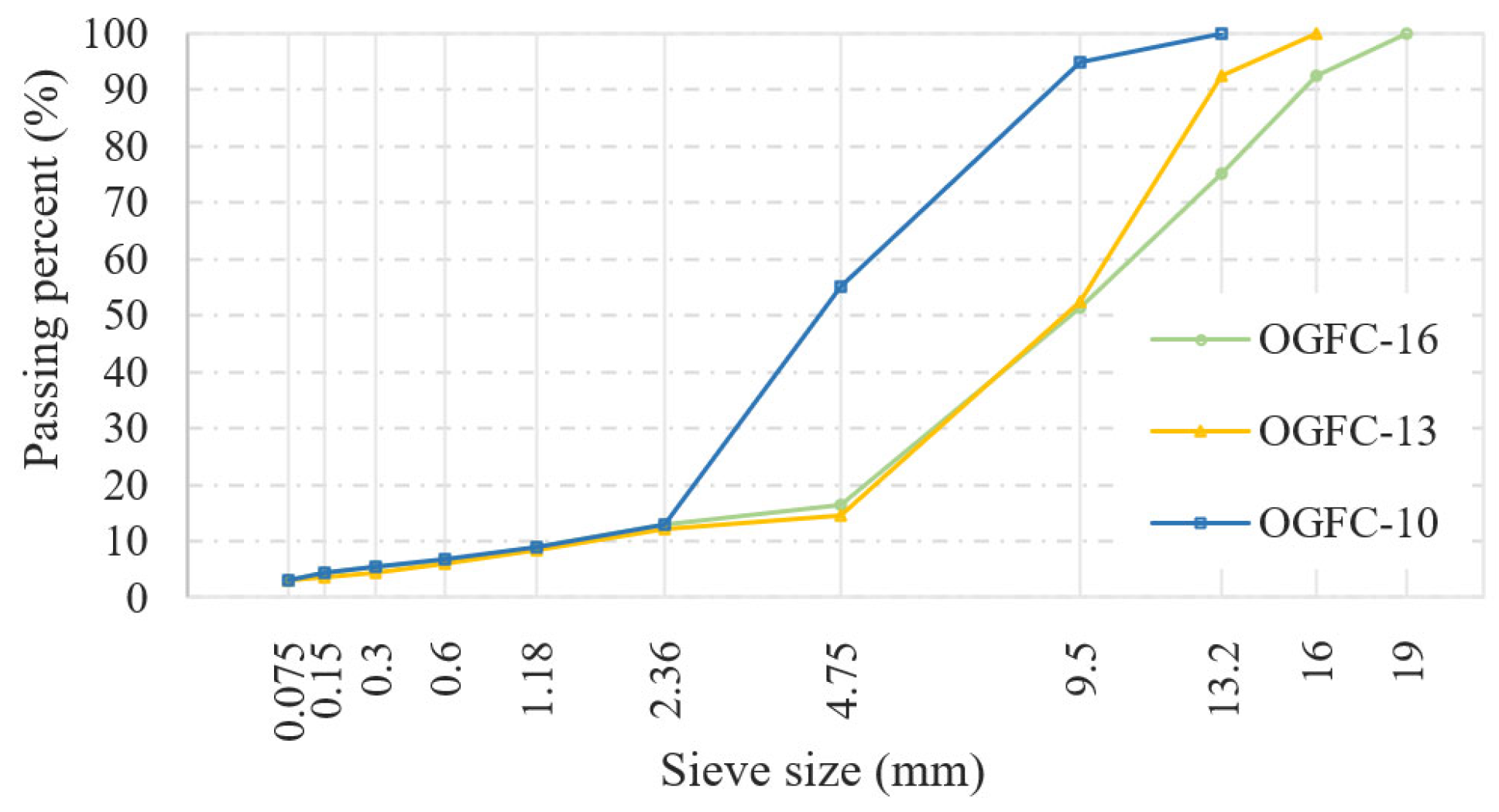
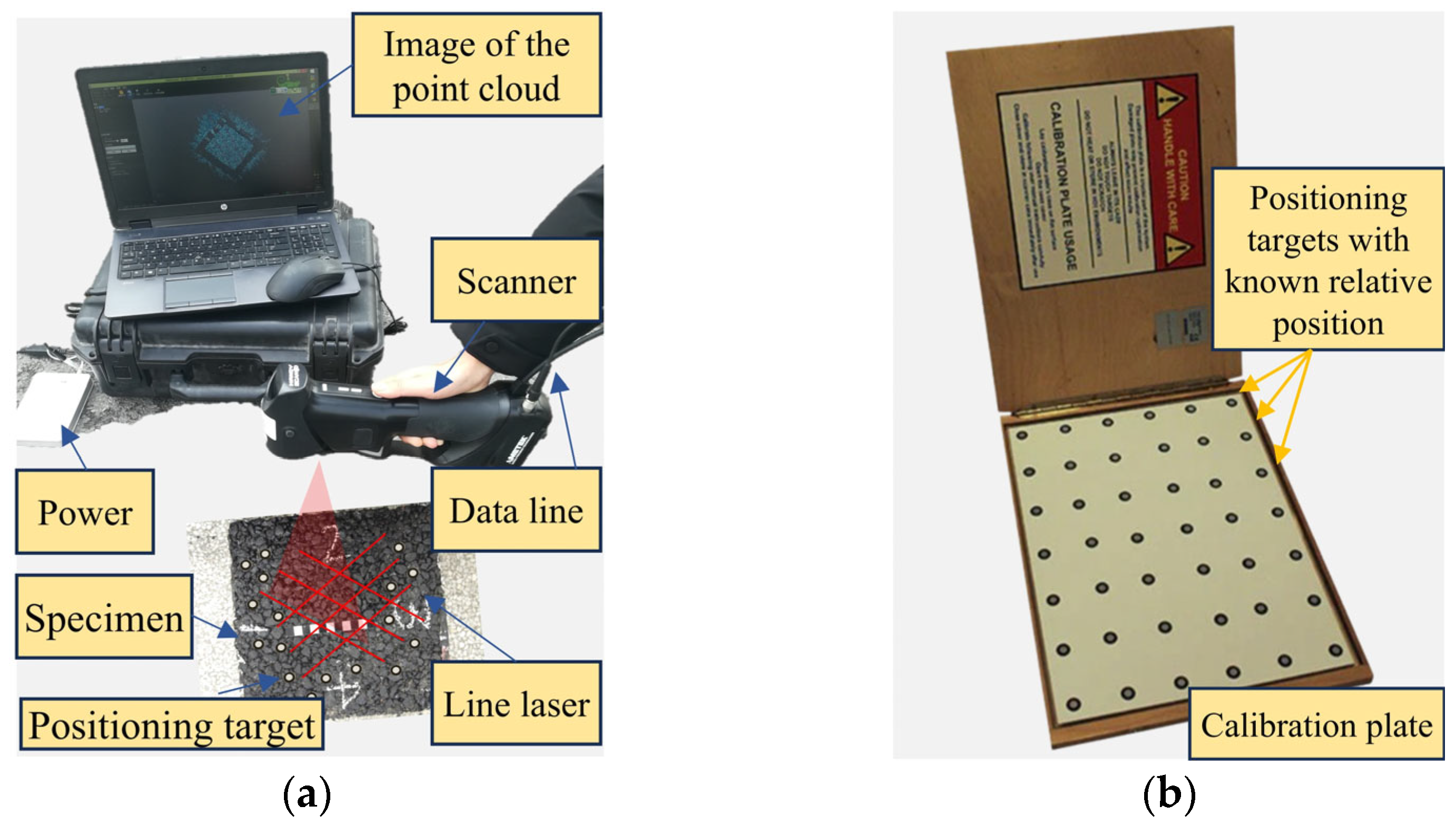
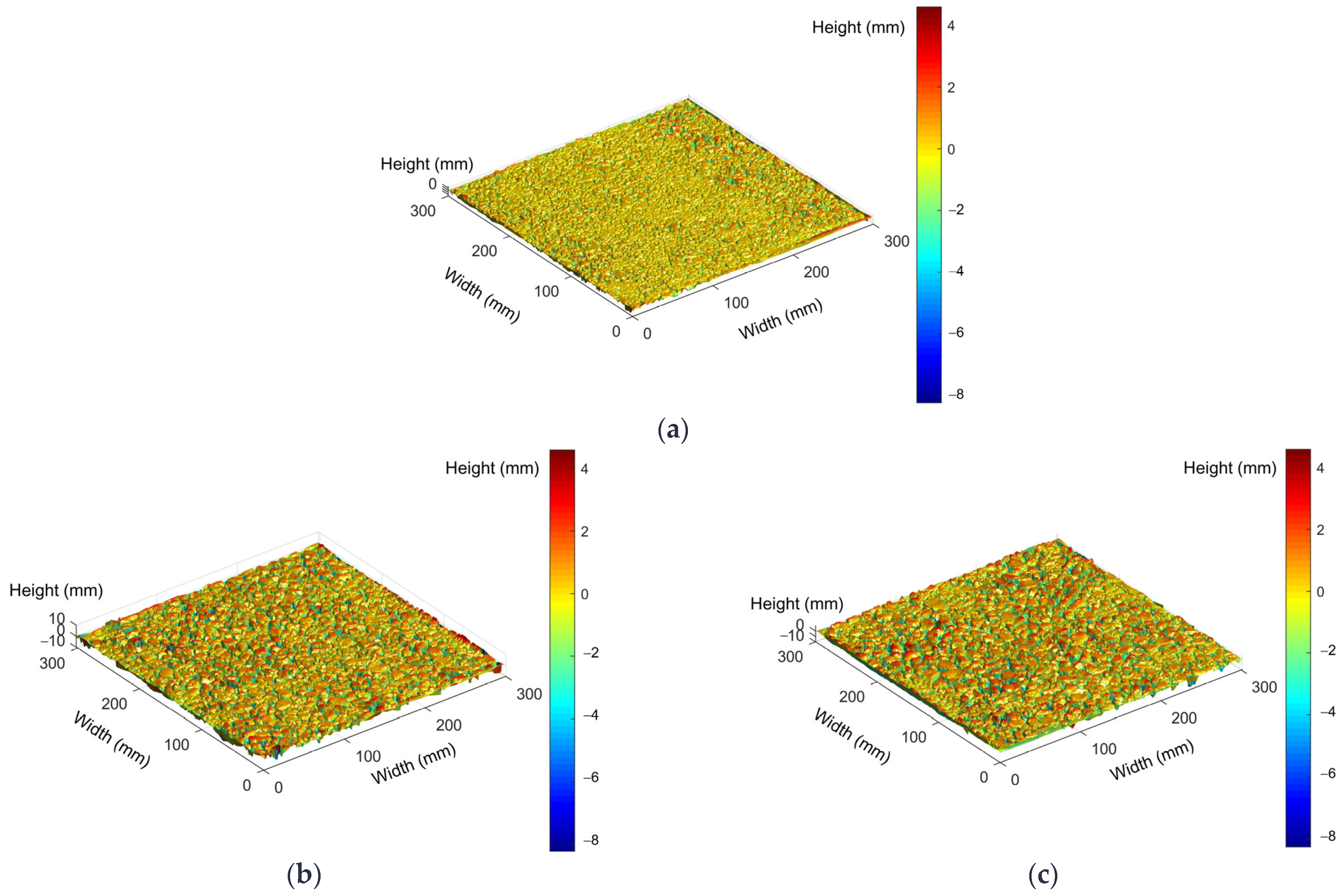

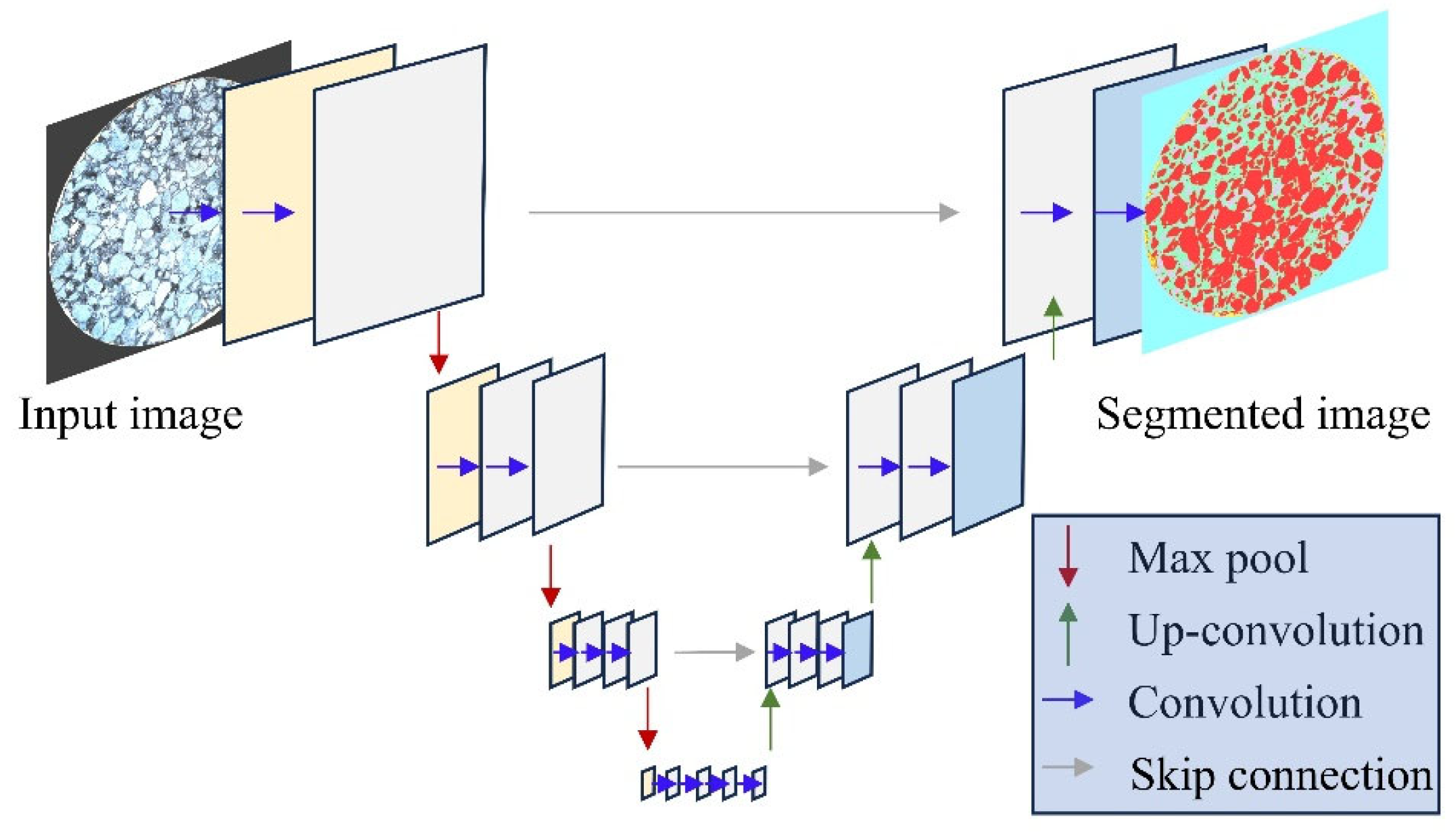



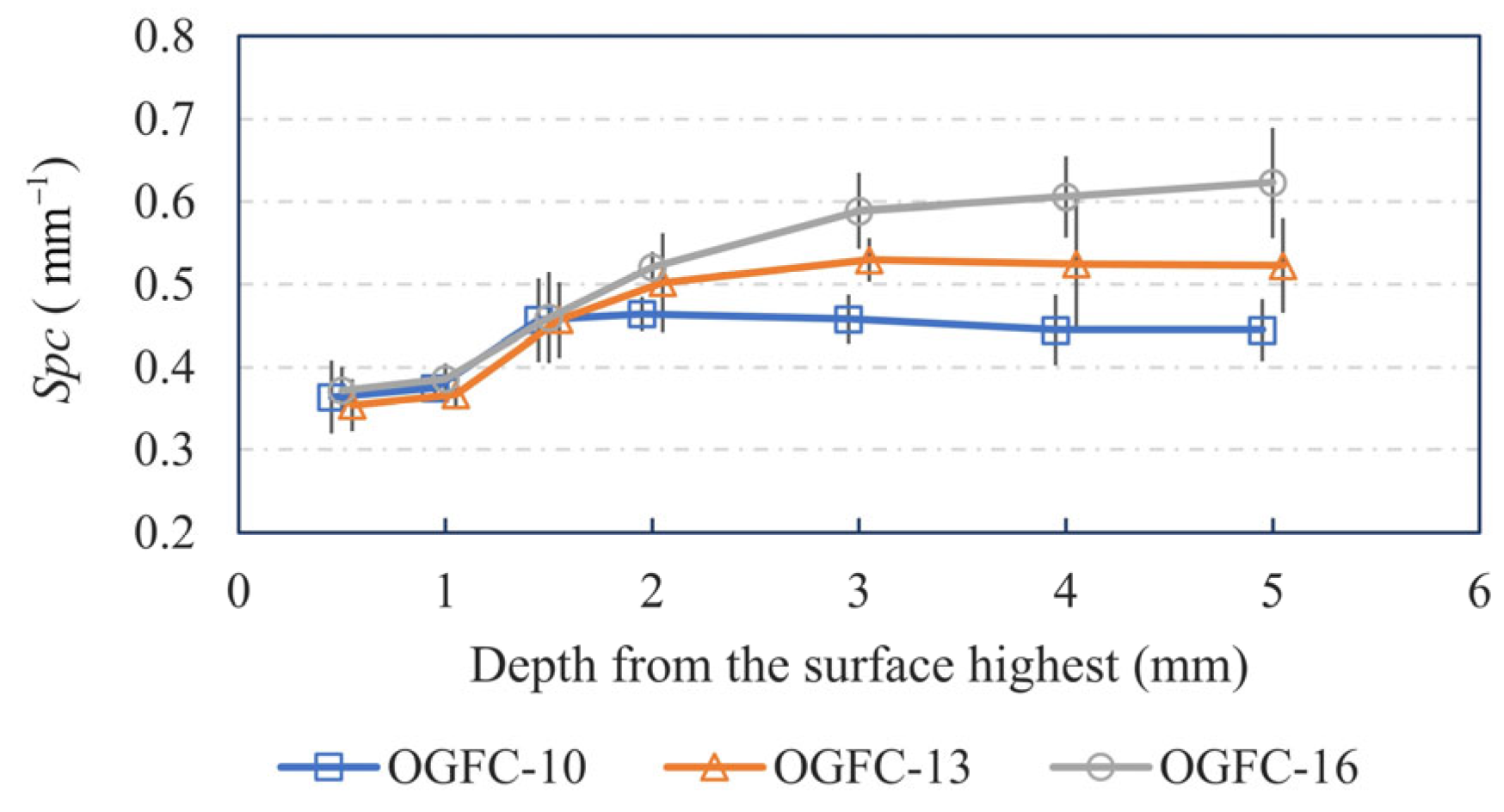
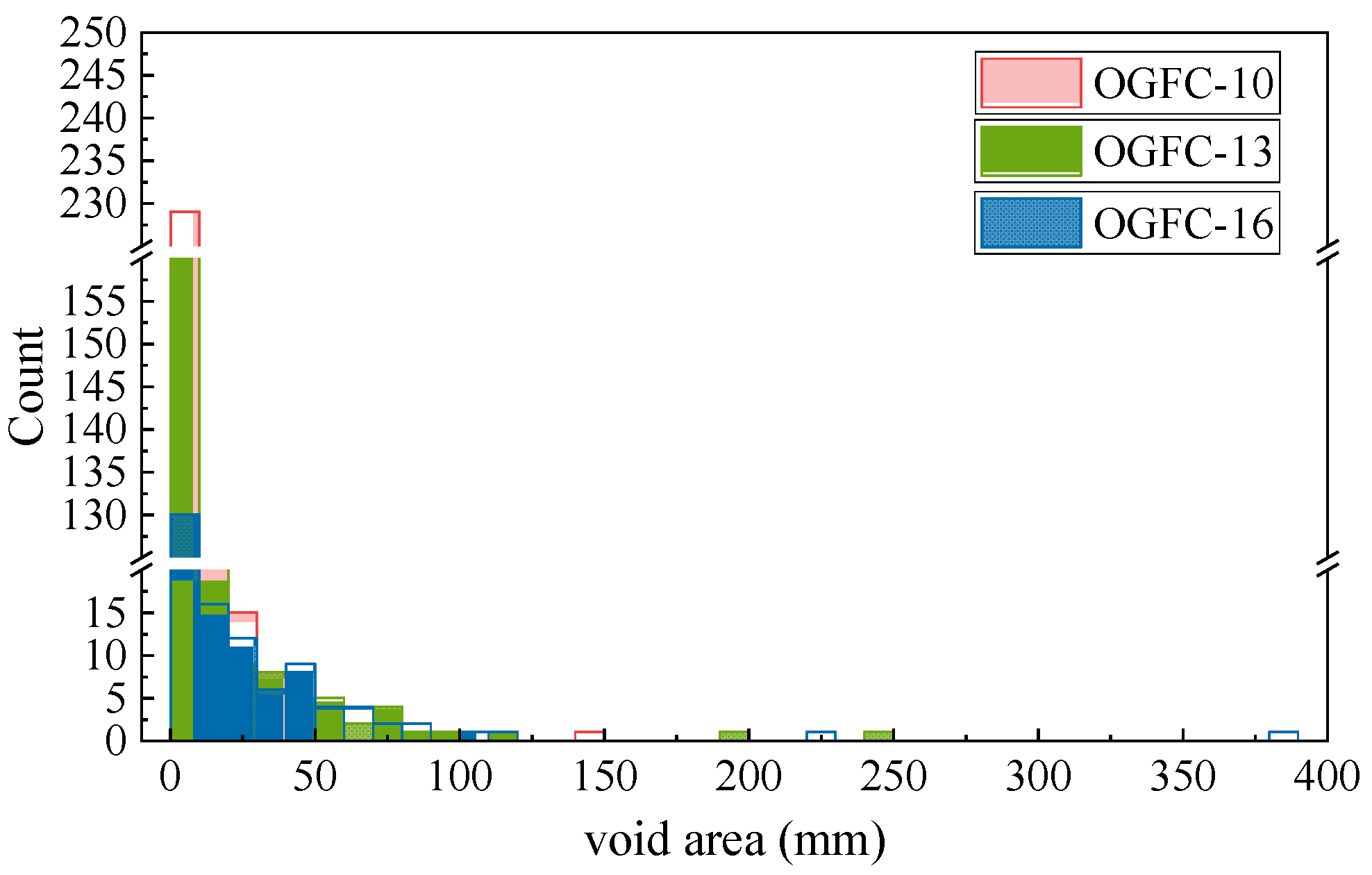

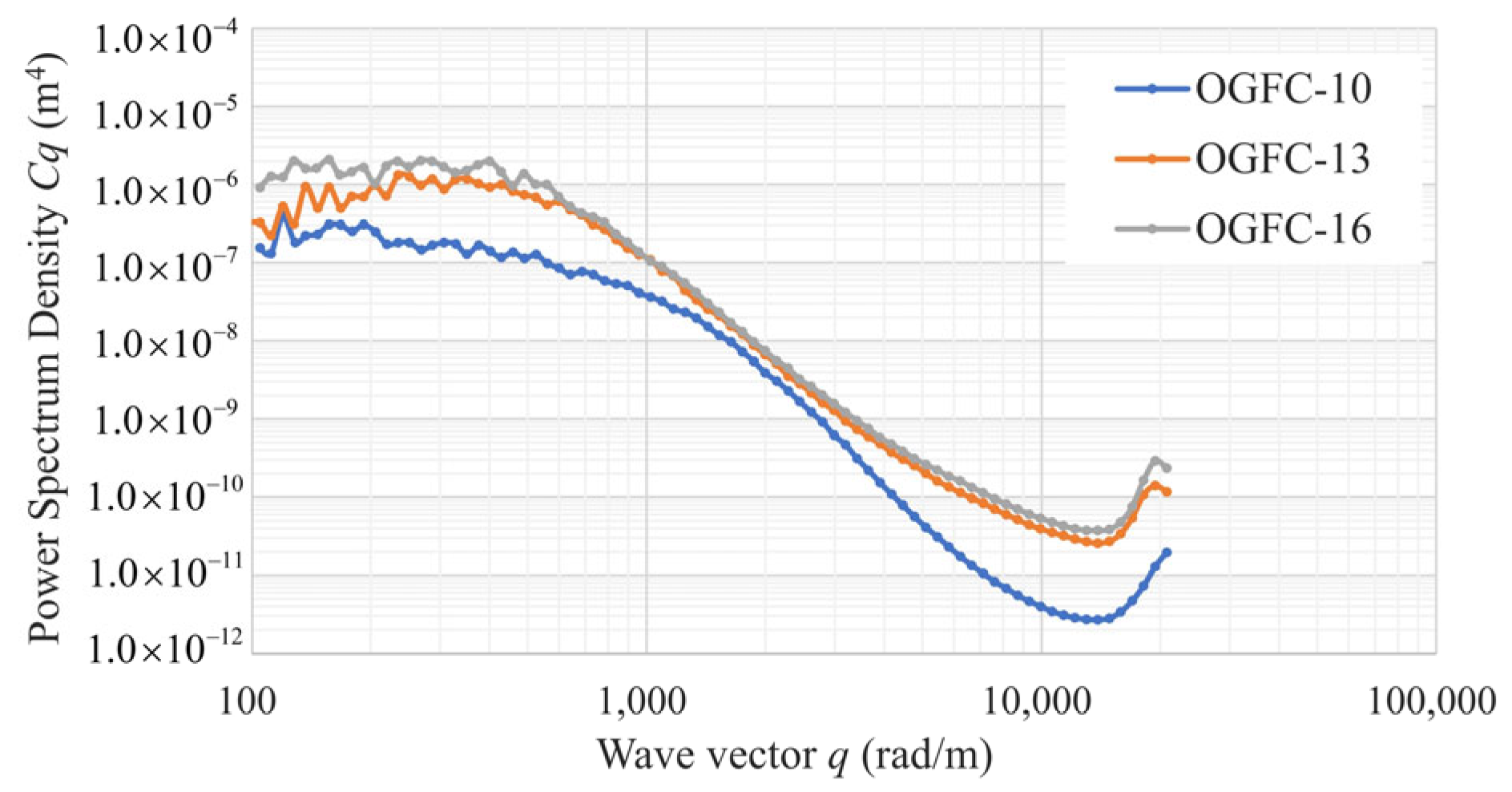
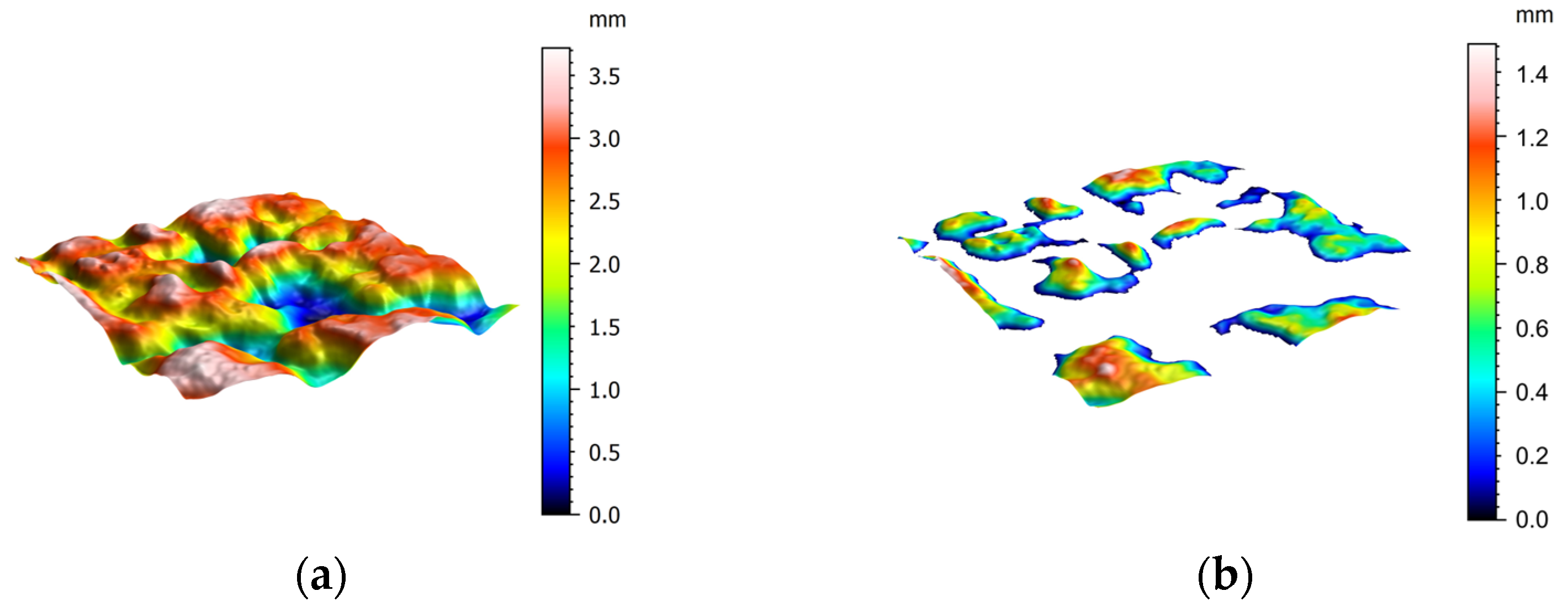
| Modifier Dosage/% | Penetration (25 °C) | Softening Point/°C | Ductility/cm | 60 °C Viscosity/(Pas) | Density/ (g/cm3) | |
|---|---|---|---|---|---|---|
| 5 °C | 15 °C | |||||
| 12 | 45 | 87.0 | 57 | >100 | 137,812 | 1.03 |
| Mixture Type | Contact Depth (mm) | Parameters Calculated Based on the Extracted Surface | BPN Value | ||||
|---|---|---|---|---|---|---|---|
| Spd (/) | Spc (/) | MPD (mm) | Max. | Steady | Reduction (%) | ||
| OGFC-10 | 0.8 | 106 | 0.37 | 0.68 | 65.8 | 55.5 | 15.73 |
| OGFC-13 | 1.3 | 202 | 0.43 | 1.12 | 64.2 | 57.3 | 10.82 |
| OGFC-16 | 1.5 | 220 | 0.46 | 1.39 | 63.4 | 51.8 | 18.37 |
Disclaimer/Publisher’s Note: The statements, opinions and data contained in all publications are solely those of the individual author(s) and contributor(s) and not of MDPI and/or the editor(s). MDPI and/or the editor(s) disclaim responsibility for any injury to people or property resulting from any ideas, methods, instructions or products referred to in the content. |
© 2024 by the authors. Licensee MDPI, Basel, Switzerland. This article is an open access article distributed under the terms and conditions of the Creative Commons Attribution (CC BY) license (https://creativecommons.org/licenses/by/4.0/).
Share and Cite
Song, L.; Yun, D.; Ye, W.; Gao, J. Characteristics of Open-Graded Friction Course Macrotexture and Macrostructure and Its Effect on Skid Resistance under Rainfall. Materials 2024, 17, 4658. https://doi.org/10.3390/ma17184658
Song L, Yun D, Ye W, Gao J. Characteristics of Open-Graded Friction Course Macrotexture and Macrostructure and Its Effect on Skid Resistance under Rainfall. Materials. 2024; 17(18):4658. https://doi.org/10.3390/ma17184658
Chicago/Turabian StyleSong, Liang, Di Yun, Wei Ye, and Jie Gao. 2024. "Characteristics of Open-Graded Friction Course Macrotexture and Macrostructure and Its Effect on Skid Resistance under Rainfall" Materials 17, no. 18: 4658. https://doi.org/10.3390/ma17184658
APA StyleSong, L., Yun, D., Ye, W., & Gao, J. (2024). Characteristics of Open-Graded Friction Course Macrotexture and Macrostructure and Its Effect on Skid Resistance under Rainfall. Materials, 17(18), 4658. https://doi.org/10.3390/ma17184658




